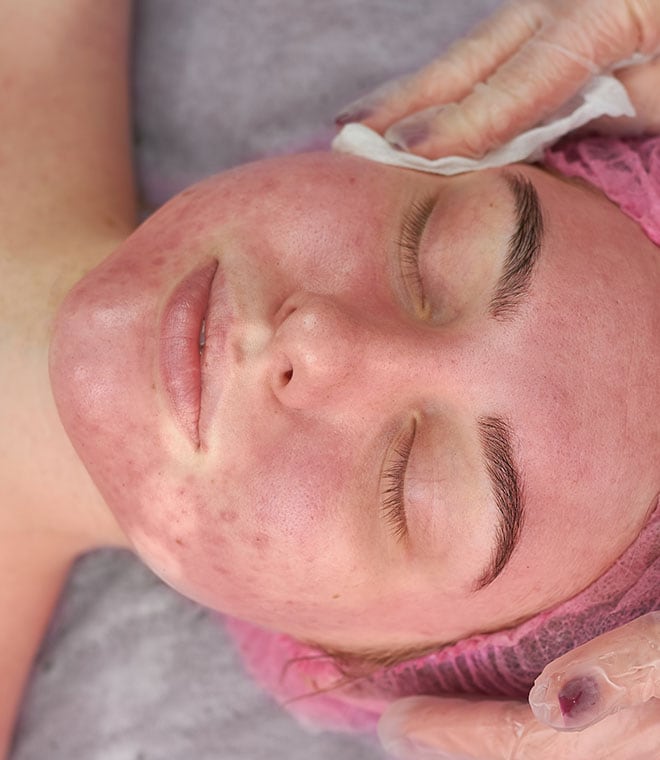Health
What is hyperpigmentation from acne?
By Anna H. Chacon, MD, Fellow of the American Academy of Dermatology Apr 08, 2024 • 8 min
Inflammatory skin conditions, like acne, sometimes leave behind dark patches and spots after they heal. This is a condition called postinflammatory hyperpigmentation (PIH), and while these dark spots may often fade on their own, it can take months or years. The good news is that there are a number of ways to help lighten hyperpigmentation from acne and improve the overall appearance of your skin.
Why does hyperpigmentation occur with acne?
Postinflammatory hyperpigmentation results from the overproduction of melanin, the natural pigments that give your eyes and skin their color. The inflammation that occurs with acne and other skin conditions triggers the cells that produce melanin to grow in size and to increase their melanin output.
PIH can occur in the epidermis, the outermost layer of skin, or in the dermis, the lower layers of skin that contain the sweat glands, hair follicles and blood vessels. When it’s limited to the epidermis, PIH is generally tan, brown or dark brown in color and likely to fade on its own over time. When it occurs in the deeper dermis layer, PIH is blue-gray in color and may be permanent. Nodular acne or cystic acne, which both occur deep within the follicles in the dermis, are more likely than other types of acne to cause more severe and lasting hyperpigmentation.
Who is most affected by hyperpigmentation?
Postinflammatory hyperpigmentation affects people of all ages, genders and skin types who have had acne or another inflammatory skin condition, like eczema or impetigo. PIH is more common in people with darker skin. As many as 65% of people with dark skin tones who have had acne will experience PIH, and the darker the skin, the more intense and longer-lasting the hyperpigmentation may be.
Acne scars vs. hyperpigmentation
While acne scars and hyperpigmentation aren’t the same thing, they both commonly occur after acne heals. Acne scars include atrophic scars, which are flat and shallow, and hypertrophic scars, which are raised lumps of scar tissue. Hyperpigmentation isn’t a scar, in that it’s not caused directly by damage to the skin and is less likely to be permanent. Whether a person has acne scars or hyperpigmentation, their self-esteem can take a major hit when the acne finally heals but leaves behind visible blemishes.
How long does it take for acne hyperpigmentation to fade on its own?
In general, PIH that affects only the epidermis (the top skin layer) disappears or fades significantly on its own within six to 12 months, while dermal hyperpigmentation may take considerably longer to fade and disappear, or it may be permanent. However, treatment can help speed up fading, prevent PIH from worsening and improve skin tone.
Treatments for reducing acne hyperpigmentation
Several treatments can be used to improve postinflammatory hyperpigmentation:
Hydroquinone. A topical skin-bleaching agent, hydroquinone interferes with melanin production in the cells, resulting in the reduction of pigment on the skin. It’s available over the counter in a 2% cream or by prescription in higher concentrations. Typically, you should see results within four weeks, but if there’s no improvement after three months, your dermatologist may recommend a different treatment. The effects of hydroquinone are reversible with exposure to sunlight, and prolonged use may cause other pigmentation problems.
Retinoid creams. Topical retinoids like tretinoin are in a class of medications chemically derived from vitamin A. Tretinoin is a prescription-only retinoid that acts on receptors in skin cells to help reduce the activity of melanin. It also helps lighten dark spots by acting as a powerful exfoliator that promotes cell turnover in the epidermis, improving overall skin tone and texture.
Chemical peels:
- Glycolic acid. A type of alpha hydroxy acid, glycolic acid is used in peels, which work by removing surface layers of the skin. Glycolic acid increases the production of collagen and helps break up melanin in the basal layer of the skin. Clinical trials show that glycolic acid peels improved PIH in people with darker skin tones.
- Salicylic acid. Like glycolic acid peels, chemical peels using salicylic acid are effective for reducing PIH. Salicylic acid is a beta hydroxy acid, and it’s generally better tolerated than glycolic acid in people with dark skin.
Azelaic acid. A naturally occurring acid that has
anti-inflammatory, antimicrobial and antioxidant effects, azelaic acid is used to manage acne and treat moderate to severe PIH. It’s thought to reduce the production and release of melanin. Side effects may include skin dryness and peeling.
Laser treatments. For difficult-to-treat hyperpigmentation, including deeper dermal PIH, Q-switched laser treatment may help improve the condition when topical solutions and chemical peels don’t work. Q-switched laser treatment produces minimal negative side effects and requires very little downtime. It can be used with shorter wavelengths for epidermal PIH and with longer wavelengths to treat PIH at the dermal level. However, PIH can be a potential side effect of certain types of laser therapy used on different skin tones.
Importance of sunscreen
Postinflammatory hyperpigmentation is a photosensitive condition, which means exposure to ultraviolet rays and visible light from the sun not only worsens PIH but can also reverse the effects of both topical and laser treatments. Certain treatments can make your skin more sensitive to sun exposure, as some of the skin’s layers are removed or lightened.
Applying sunscreen daily is crucial for people with PIH, especially for those who have dark skin.
Camouflaging hyperpigmentation
Postinflammatory hyperpigmentation can seriously impact self-esteem and reduce quality of life. During treatment for PIH, consider using makeup to conceal hyperpigmented spots. An aesthetician who specializes in makeup can help you choose the right products and show you how to use them.
Postinflammatory hyperpigmentation is a common skin condition left by inflammatory skin disorders, including acne. Although it most often occurs in people with darker skin, anyone can experience hyperpigmentation. Because many of the treatments used to lighten the skin or reduce the production of melanin can worsen the condition if improperly used, it’s important to visit your dermatologist to determine which treatment is best for your skin, including the ideal strength of topical treatments and duration of treatment.
Hyperpigmentation from acne takes time to fade, so patience is crucial. If you follow your dermatologist’s directions closely and always wear sunscreen — even on cold or cloudy days — chances are, you’ll see a marked improvement in your PIH over time.
Clinically reviewed and updated by Julie McDaniel, MSN, RN, CRNI, April 2024.
Sources:
- https://www.aad.org/public/everyday-care/skin-care-secrets/routine/fade-dark-spots
- https://www.uptodate.com/contents/postinflammatory-hyperpigmentation
- https://www.dermatologyadvisor.com/home/topics/general-dermatology/managing-patients-with-pih-and-skin-of-color/
- https://www.ncbi.nlm.nih.gov/books/NBK559150/
- https://www.aocd.org/page/Hydroquinone
- https://www.aocd.org/page/Retinoidstopical
- https://www.aad.org/public/diseases/acne/derm-treat/scars/causes



